On May 9th 1997, a weird little sci-fi action flick called The Fifth Element was released in theaters, from the same man who had recently brought audiences Nikita and Léon: The Professional. It was widely lauded/derided for being the one of the best/worst science fiction films ever made. It delighted/pissed off everyone who had the chance to see it. It was nominated for prestigious awards/Golden Raspberries, and is regularly cited for how well/terribly it tackled gender themes, design, and humor.
Twenty-five years later, no one can seem to agree on where it belongs in the pantheon of sci-fi cinema—and it’s safe to say, that is part of its unyielding charm.
Story goes, the general concept for the film was something that director Luc Besson created as a teenager while trying to stave off boredom. Besson would later claim that he saw Star Wars around the same time, and would be inspired to create a film on a similar scale… but that when he finally started making movies, the technology was still too far behind to create the film he wanted to make. After enough advances were made, Besson would work for years to make the movie a reality, obtaining the funding and the talent for it. He hired Jean Giraud (Moebius) and Jean-Claude Mézières to work on the film’s production design, inspired by their work in comics. He got the legendary designer Jean Paul Gaultier to create every meticulous costume. He talked Gary Oldman into playing Zorg by helping to finance one of Oldman’s other projects after they worked together on Léon. He created a 400-word alien language for Milla Jovovich to learn as Leeloo. He hired an unconventional cast compiled of veteran actors, comedians, musicians, and models.
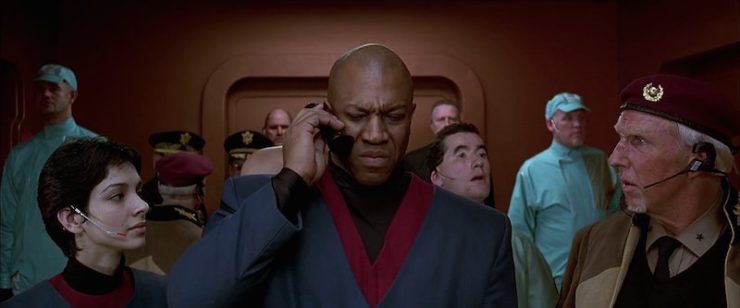
The Fifth Element is an odd duck because it seems as though any of its more bombastic leanings should cancel one another out, and yet it somehow manages a delirious cohesion. It is loud and dark, funny and frightening, heavy-handed but full of mesmerizing and carefully rendered detail. It is the cinematic equivalent of Rococo artwork, of New Years Eve fireworks, of a gorgeous rainbow cocktail that gives you the worst hangover of your life. It is really no wonder that some people are drawn to it like moths, while others bounce off of it and run the other way.
It is a movie that is full of contradictions as well, perhaps too many to number. It seems to deride reliance on technology and slavish adherence to consumerism—yet many of the vibrant visuals that draw the audience in are resultant from those technologies and objects. It is a story about a woman who was created to save the universe—but she can only manage it if a man will tell her that he loves her. It is a film that extols the average Joe masculinity of men like Bruce Willis—and then counters it with some of the queerest, un-macho, gender-bending male costars that have ever been seen in a blockbuster. It is a tale about the folly of humanity in creating the means of its own destruction—but still relies on the presence of Absolute Evil to bring about total annihilation. These contradictions make it a strange film to critique; focusing on any one of these aspects can result in a massively different reading of the film.
The greatest strength of The Fifth Element is by far its sense of humor, which is something that most big-budget science fiction films never even attempt, much less manage to pull off. The effectiveness of that humor is bolstered by the sharpness of a script that regularly intercuts separate but related conversations with dizzying speed, making flawless editing one of the keys to its success. Everything that the film excels at only plays into the comedy; the lavish surroundings, the clutter, the costumes, the precise soundtrack. The fact that the film is funny also helps to assuage some of the cognitive dissonance for how over-the-top everything is, from Zorg’s tantrums to Mister Shadow’s appearance as a giant ball-of-black-whatever in space to Ruby’s non-stop patter. The way the humor dissipates is entirely centered on Leeloo’s emotional and mental state—when she is frightened or angry or in need of help, the film takes her needs seriously. But darker events that occur around everyone else, events that could be harrowing or disturbing—as when Korben Dallas is held up for money at his own front door by a man who is clearly incredibly high—are always meant to be viewed with a sense of humor.
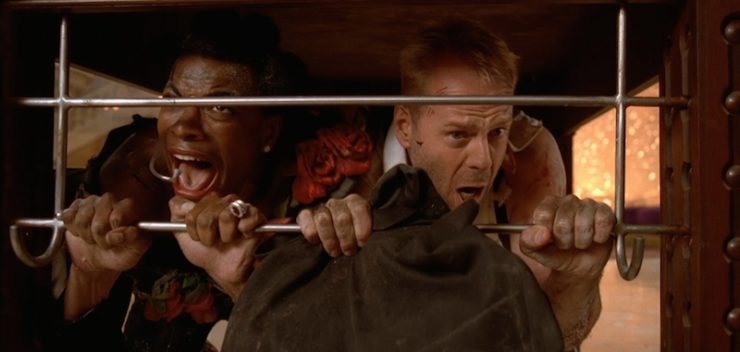
The giddy design of the film’s locales were purposefully rendered with garishness in mind; Besson was tired of seeing dark, dingy spaceship corridors in science fiction and wanted his film to depict a “cheerfully crazy” glimpse of the future. There is a sense of constant transgression built into the film by repeatedly denying its audience the tropes that they are comfortable with in this way; the future is messy but full of color and warmth; the scientists who reconstruct Leeloo from the Mondoshawan crash keep assuming that someone with such perfect DNA must be male; the main protagonists never meet their main antagonist (Zorg is completely unaware of Korben’s existence and vice versa). The Fifth Element has a familiar mythic structure, but it is tempered by moments of sheer sacrilege in communication of that arc.
At the center of the story is the titular Fifth Element, a character of great polarization among viewers, fans, and critics. There have been countless deconstructions of Leeloo, and she contributes to some honestly aggravating conceits for Strong Female Characters, whether it’s the “silent, ass kicking young woman” who seems to be everywhere these days, or the recently named “Born Sexy Yesterday” problem that plagues many female protagonists. There’s also the fact that she refuses to do her world-saving without confirmation that Bruce Willis loves her, which could strike anyone as a little negligent. (It doesn’t help that we all know she could do better than Dallas, proficiency with spaceships and guns not withstanding.)
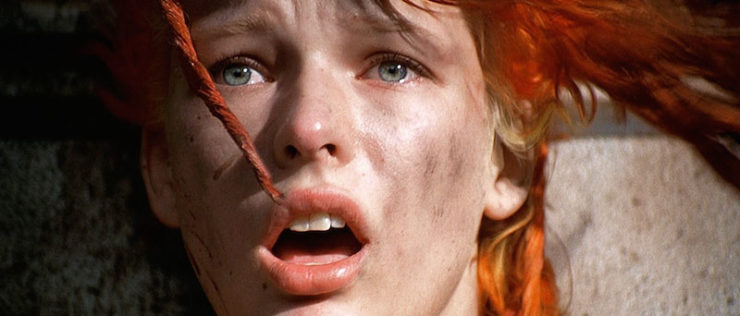
But it’s hard to deny that very few female heroes are permitted the range that Leeloo is allowed in such a short span of time; innocence coupled with wisdom, strength alongside immense vulnerability. Most of this is down to Jovovich’s performance, which is captivating from the first frame. She can move from wide-eyed wonder to tears in the space of a moment, and it’s hard to feel as though you’re not being pulled into her orbit the same way Korben is. If the ending of the film seems too corny, it’s easy to believe that the two of them go their separate ways not long after the finale—they don’t really seem like a romance that will outlast the burning of the sun. Leeloo’s desire to learn and grow and experience life is clearly around for the long haul, though.
Many readings of The Fifth Element center on the gender dynamics, either by narrowing in on Leeloo’s simultaneous fulfillment and rejection of certain feminine tropes, or focusing on the interesting mixed signals the film gives off about masculinity. Korben Dallas is like most characters that Bruce Willis has played over the course of his career—sarcastic everymen who offer a sort of updated version of the cowboy archetype, cynical until the right moment comes along and something softens them up. There are critiques of the film that point to the fact that every other man in the story seems entirely incompetent next to Dallas, making his particular brand of manliness seem supernatural by comparison.
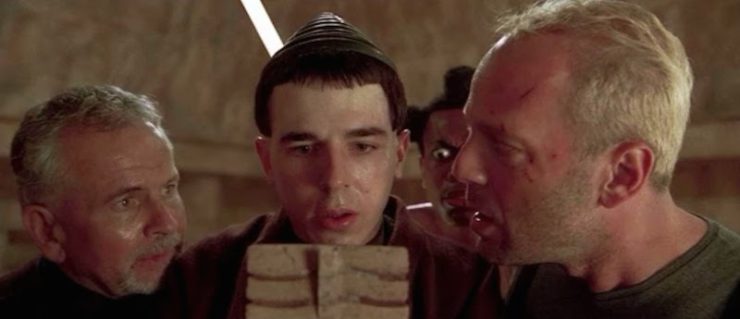
But this reading leaves out the proper deference due to radio DJ Ruby Rhod (whose name is either a reference to a periodic table pun, a component of laser design, a cute play on feminine and phallic combinations, or some amalgam of any of these), a role originally designed with Prince in mind before going to comedian Chris Tucker. Rhod is one of the characters who divides audiences and critics, but love or leave him, the film is a completely different animal without his presence. The desire for the character to play around with gender norms was intrinsic from the beginning; figuring that the look might be a hard sell, Besson came prepared with costume sketches for Tucker, showing him variations on the outfits that ended up on camera. When Tucker proved wary, as Besson was expecting, he showed him even more flamboyant costume design options… which led to Tucker accepting the initial drawings as the more mellow option.
It would be easy to say that Ruby is there to make Korben look “cooler” by being the frightened, effeminate counter to Dallas’s rugged machismo. But Rhod is always rendered as sexually appealing to practically all women and to his queer entourage—which still marks him as a powerful person according to traditional tenets of masculinity. He is beloved by countless fans, he has wealth and fame. Moreover, while Ruby spends his initial time with Korben struggling to get the man to say more than a word in reply to his questions, the eventual result of their time at Floston Paradise shows Korben willfully participating in Ruby’s show in order to receive his aid, an inevitable trade as the show is live during the attack on the resort. In short, Ruby Rhod gets exactly what he wants from the situation; the “best show he ever did.”
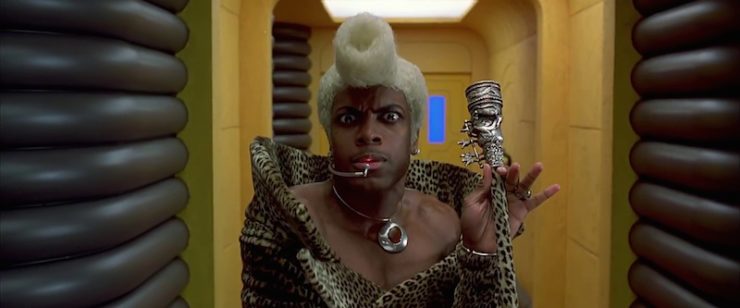
People can choose to quibble with the character’s construction or depiction, which certainly comes with its own pitfalls and debatable points. But when all is said and done, there has never been a male character in an action-filled blockbuster who was more openly flamboyant, transgressive, and enveloped in queer codification than Ruby Rhod. That filmmakers have been so afraid to emulate that bold choice makes Ruby special, but it’s impossible not to criticize his lonely status in cinema.
Characters and gendered thematic resonance aside, The Fifth Element is a movie that aims to engage as many senses as possible. It is full of slick textures and dimension, practical effects and sets, music that overtakes. If the film were known only for the showstopping “Diva Dance” number, that would be a good enough reason for its legacy—an utterly alien experience with unmistakable visuals and melodies that linger on forever. It makes the most out of what film does best. In that way, it is hardly surprising that Besson was enamored of Star Wars, as George Lucas has always had a similar approach to film: medium first and story second. It doesn’t work for many creators to function this way, but Besson has an incredible knack for making his style into substance, rather than divorcing those two concepts entirely.
Film critic Armond White has said that Besson writes stories that are about “conscientious resistance to human degradation.” The Fifth Element bears out under that observation; many characters are working to aid evil, and many more are doing nothing to stop it, but the film is unerringly optimistic about humanity’s ability to retreat from darkness. While the viewer is encouraged to ask the same questions that Leeloo asks of herself and those around her, to wonder at the value of preserving life when it is full of suffering, the ultimate answer is still one of hope. Zorg may believe in destruction, but Besson has deliberately equipped him with faulty reasoning; in the film, he makes the argument that life is built on chaos, reciting his own version of Bastiat’s “parable of the broken window” without knowing that the old French economist already broke this concept down as a fallacy in the 19th century. Zorg is meant to sound smart and appear competent, but he is mistaken on the most basic level—while even the most inept agents of good are still plugging away at averting the impending disasters of their era.
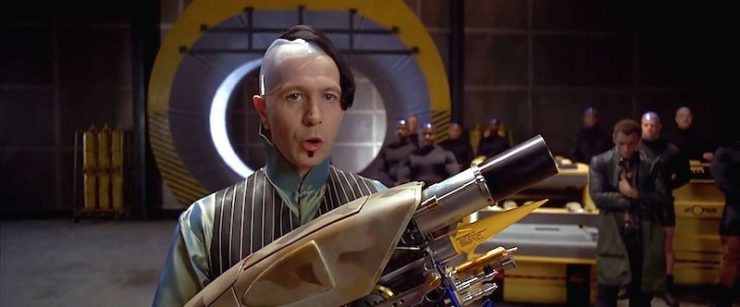
You could go so far as to say that The Fifth Element believes you do not have to recognize evil in order to fight back against it. You simply have to care enough to get up off your butt and do something. And you can do it in cheesy technicolor and rubber suspenders and three-dimensional traffic. Austerity gets you points as far as the Academy is concerned, but if you want to stick in people’s minds, you have to add in a few blue aliens and weird stones with symbols etched into them. Film is an art form for our eyes and ears, and sometimes that should be rewarded with more than period costumes and sorrowful string sections.
So it’s been twenty-five years. And The Fifth Element is still the best/worst science fiction film you’ve ever seen. Then again, we’re still talking about it… which means it probably can’t be all bad.
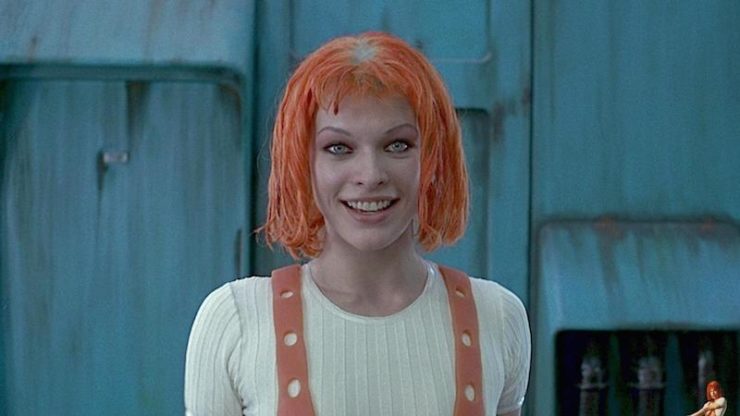
Originally published May 2017.
Emmet Asher-Perrin isn’t going to bother to deny their adoration for this movie. You can bug them on Twitter and Tumblr, and read more of their work here and elsewhere.










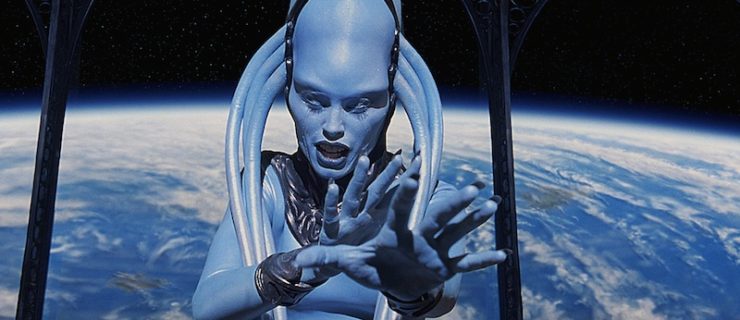
Super-Green! This film is the best. Fun, Fun, Fun.
The only knock (well, the only major knock) I have against this movie is Tom Lister’s (the President) “acting.” I cringe whenever he says a line.
Thank you for surfacing this: I hated Fifth Element on first viewing, expecting a serious, hard-edged SF film after Nikita and Leon.
I loved it the second time I watched it because it is so much fun, and the visuals are still great today (some rubber suit characters notwithstanding)
Like “Starship Troopers”, I didn’t really ‘get’ “The Fifth Element” on first viewing, then saw it again much later and suddenly realized how much there is to like about it. Much of “The Fifth Element” is nonsense; much of it is brilliant. And much is both at once. Above all, it’s fun.
It took me the second viewing to realize that Ruby Rhod isn’t simply a gratuitous caricature, but an essential part of the story and a developed character in their own right. I think the interview scene is comedic genius, and works because both actors turn in superb (and utterly different) performances. Part of the charm is that there’s no cruelty in it: a scene that tried to get its laughs by mocking the flamboyant gay-coded character would be very nasty indeed. But there’s no hint of bigotry — Dallas is frustrated with the situation, not with his interlocutor — while Ruby comes across as an absolute professional working with very difficult material.
It’s interesting to compare with “Valerian”, which has the same gloriously intense visuals, but is — to me at least — vastly less satisfying. You could point to many ways in which “Valerian” falls short — the more convoluted and less engaging plot, the fact that DeHaan and Delevingne simply aren’t at the same level as Willis and Jovovich and so on. Ultimately, though, my feeling is that “The Fifth Element” has a heart, and “Valerian” simply doesn’t.
I was 32, less than 10 years out of the army, and was (still am…) as straight white male as you could be, and loved this movie from the moment I saw it. One of the first dvds I bought, and I have it on blu ray. So much fun
Agreed 200%!
Thanks to the sad health news about Bruce Willis, his movies are getting lots of playing time on the cable channels. THE FIFTH ELEMENT is on current rotation.
I love this film. It has so many good set pieces! Scenes that can be rewatched a million times out of context and still get delight from them. It made me think about how important scene is to a reader/viewer. How we remember moments in a story through good scenes. As a writer, i find that helpful. But also, Besson is just so lavish in giving moments to characters and to the viewer that are pure entertainment. The opera is one of them. That is just beautiful. And lets the viewer pause for that beauty. I can laugh and enjoy this movie, even with its flaws, as often as the scifi channel plays it (which in 2013-2015 was often!)
@@@@@ 2: I have not seen Tom Lister in anything else that I can recall, but frankly I have no problem with what he does here. He makes the president look and sound like a self-important, vacuous figurehead, and that’s what the role calls for.
Part of the genius of Ruby Rhod is that he’s the character with the Everyman viewpoint. He’s the guy trying to do his job while being dragged along in the hero’s nonsense. He did not sign up for this. But he’s also…Ru-by Rhod!
I still re-watch this movie periodically. The music, the romance, the pacing, the costumes, the city, the faces you did not see in American films of that era (and still generally don’t), the feeling that the whole thing is a Heavy Metal comic come to life…even the sexism, which is almost cartoonishly cute. We quote it to one another in my family. Somebody needs a flashlight? “Aziz! Light!”
Tangential: More than one person has actually sung “Diva Dance,” live and unmixed.
I love this movie. In addition to just being excellent, it did not escape my straight male self that while people had always been telling me a “man” is like Korben, it was clear that Ruby was having a LOT more fun.
When it comes to the question of competence: there is a section in the middle of the movie where the guy who is good with guns gets his time to shine. But then at the very end, he almost gets all of life on Earth killed because he can’t say I Love You. I always thought this movie did a really great job of showing why multiple viewpoints and skill sets are so important to have around.
When I first saw this movie I wondered if there were actually three or four movies that had to be cut up just so they could release something.
Turns out (of course I got one of the “special features” editions!) that there were quite a few storylines in the script that never really made it into the film. But they were kinda there, in the background, and the remaining script and all the characters all knew about them. Which makes the movie feel a lot more built-out and the universe a lot more lived-in than the actual movie probably deserves.
I still do not know if this is 1/5 stars or 5/5 stars. I guess it depends on the scene. But it’s still one of my favorites.
Regarding influences, I see wayyy more Anibal 5 and Heavy Metal (the magazine) than Star Wars in it. This makes sense given the Moebius connection and given that Besson is French.
It wasn’t that Leeloo wouldn’t save the world unless Korben told her he loved her. Leeloo had seen the worst of what mankind had done to itself. Wars, genocide, nuclear weapons etc. What she experienced since being reconstructed was nothing but violence. She was wondering why she should save humanity when all we do is inflict evil on each other. She needed to understand the good in humanity so she had a reason save it. Once he told her he loved her and they embraced/kissed she felt true love and she knew humanity was worth saving
This movie is a 6 out of 5. I find absolutely nothing wrong with it.
As far as Emmet’s comment “There’s also the fact that she refuses to do her world-saving without confirmation that Bruce Willis loves her,” I think this misunderstands her role as the Fifth Element. The four elements are earth, air, fire, and water (and the stones used the ancient Greek symbols). But some Greek philosophers posited a fifth element, aether, which was the heavenly realm. Leeloo was the embodiment of this, sent from the heavens to judge humanity. In the movie, humanity has to prove it was capable of love to justify its continued existence. It’s not that she needs a particular individual’s love or she’ll refuse, it’s that without demonstrable personal love, rather than just good deeds, the Earth has to be toast.
Saw this at the theater when it came out. Have seen it many times since. It’s just fun.
Aziz LIGHT!
Disappointed that the author didn’t mention the rather obvious Heavy Metal influence. The taxi chase scene at the beginning is an obvious copy/homage/ripoff of the Harry Canyon act in the movie.
I love this movie. Its got a bit of everything; a scenery chomping villain in Zorg, the virtuous priest that the powers that be don’t believe, the down on his luck hero, LeeLoo. The side characters who are themselves fascinating.
But you really have to watch it a couple of times to get thru the chaos. One viewing is not enough.
I LOVE this movie! Saw it in LA opening week with a friend and his wife, with her sitting between us up front in the theater because we were late getting there. When Ruby Rhod started his show on the spacecraft, and was all crazy loud until he starting slow talking one of the flight attendants, talking his way down her body, with the scene going loud as the spacecraft took off around her obviously enjoying the “moment” as her legs went up in the air, my friend’s wife and I looked at each other and busted up laughing out loud in an otherwise quiet audience being overwhelmed by the scene and loud music, which only made us laugh even harder. The movie ran frenetically on from there but I will always remember that moment and how funny this movie can be.
This movie was revolutionary for me when it came out. I was a baby pagan fresh out of the broom closet, and here comes a sci-fi epic with elemental philosophy. So I already knew that there were five elements, not just from studying paganism, but also as a major fan of Captain Planet. Call it Spirit, Heart, Akasha, Aether, or what have you, the fifth element has always been the unifying force that combines the other four material elements. So when Korben finally tells Leeloo that he loves her and she blasts the Dark Planet, no matter how many times I see it, it gives me the same full-body chills that it did the first time.
Also, an interesting theory we can suppose from the film is our moon was a previous Dark Planet. Wild stuff.
I’m still waiting for my Multi-Pass!!!
This is one of the rare movies that I went to see in the theatre for a second time.
Good review, Emmet. :)
And Ruby absolutely rocked :D
Father Cornelius (Sir Ian Holm) was another great character, and had one of the funniest line, “Weddings are one floor down, my son. Congratulations.”
my favest film ever and I got the tattoo too! <3 but I tell people it’s the Windows logo for lifetime activation license
@22 Doesn’t he say the same thing to the group of guys Zorg sends to get him?
I dunno why, but the way LeeLoo pronounces moooltipass makes me feel all warm and funny down there.
I have such a soft spot for this movie. I agree with most critiques, but issues that might normally niggle are forgotten in the face of Besson’s sheer exuberance. It’s just so *gleeful* – I can’t help but have fun watching it.
I always wanted to know more about the Mondoshawans. Their design was so striking, with an amazing steampunk aesthetic; they must have had an incredible backstory.
And that “Diva Dance” sequence is one of my all-time favourite movie scenes.
@20 – about a year ago I discovered – to my utter delight – that there is an entire cottage industry of folks with 3D printers who make multi-passes :)
When I saw it 1st run, I was decidedly NOT fond of it. Being something of a pedant, I crashed into its archaic concept of what constituted an “element” and the film never recovered. In addition to being a pedant, I’m also a hypocrite, because I adore Sapphire and Steel, despite the fact that the series commits no less violence against the concept of what an element actually is than the cited movie does. I suppose I should watch it again. I actually didn’t mind Valerian and the City of a Thousand Planets, which I went to see out of affection for the source material.
I watched the movie as a result of this review, and yes, it’s delightful. The Diva Dance sequence is spectacular.
I have thousands of movies in my collection, and naturally used to claim it was impossible to pick one as my favourite, or the best. Eventually I realized I was hopelessly wrong. All I had to do was apply a new paradigm. I only have one movie where I can never, ever chapter skip or turn it off before the end. I can’t because at every single point in this movie, something far too wonderful to even consider missing will happening in the next miopment or so.
How can you possibly improve on that ?
@@@@@ 24: YES! It is one of many hilarious lines in the movie.
The Extraordinary Adventures of Adèle Blanc-Sec is by the same director and well worth seeing.
@31 interesting… How faithful would you say it is to the BD? The Wikipedia article you link to seems to say that they chopped and spliced several volumes together for the movie.
I’d never heard of the comics before I saw the movie, so I have no opinion about how faithful it is.
@@@@@ 31: WHY AND HOW HAVE I NEVER HEARD ABOUT THIS MOVIE?????
I love the Fifth Element! This article was an enjoyable read and very well written – thank you.